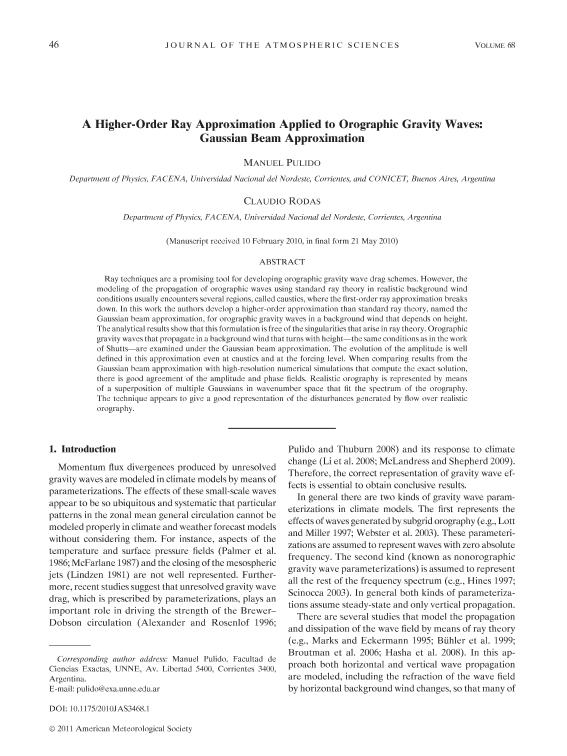Mostrar el registro sencillo del ítem
dc.contributor.author
Pulido, Manuel Arturo

dc.contributor.author
Rodas, Claudio José Francisco

dc.date.available
2021-12-14T12:03:15Z
dc.date.issued
2011-01
dc.identifier.citation
Pulido, Manuel Arturo; Rodas, Claudio José Francisco; A higher-order ray approximation applied to orographic gravity waves: Gaussian beam approximation; Amer Meteorological Soc; Journal of The Atmospheric Sciences; 68; 1; 1-2011; 46-60
dc.identifier.issn
0022-4928
dc.identifier.uri
http://hdl.handle.net/11336/148687
dc.description.abstract
Ray techniques are a promising tool for developing orographic gravity wave drag schemes. However, the modeling of the propagation of orographic waves using standard ray theory in realistic background wind conditions usually encounters several regions, called caustics, where the first-order ray approximation breaks down. In this work the authors develop a higher-order approximation than standard ray theory, named the Gaussian beam approximation, for orographic gravity waves in a background wind that depends on height. The analytical results show that this formulation is free of the singularities that arise in ray theory. Orographic gravity waves that propagate in a background wind that turns with height?the same conditions as in the work of Shutts?are examined under the Gaussian beam approximation. The evolution of the amplitude is well defined in this approximation even at caustics and at the forcing level. When comparing results from the Gaussian beam approximation with high-resolution numerical simulations that compute the exact solution, there is good agreement of the amplitude and phase fields. Realistic orography is represented by means of a superposition of multiple Gaussians in wavenumber space that fit the spectrum of the orography. The technique appears to give a good representation of the disturbances generated by flow over realistic orography.
dc.format
application/pdf
dc.language.iso
eng
dc.publisher
Amer Meteorological Soc

dc.rights
info:eu-repo/semantics/openAccess
dc.rights.uri
https://creativecommons.org/licenses/by-nc-sa/2.5/ar/
dc.subject
GRAVITY WAVES
dc.subject
NUMERICAL ANALYSIS/MODELING
dc.subject
OROGRAPHIC EFFECTS
dc.subject
WIND
dc.subject.classification
Física de los Fluidos y Plasma

dc.subject.classification
Ciencias Físicas

dc.subject.classification
CIENCIAS NATURALES Y EXACTAS

dc.title
A higher-order ray approximation applied to orographic gravity waves: Gaussian beam approximation
dc.type
info:eu-repo/semantics/article
dc.type
info:ar-repo/semantics/artículo
dc.type
info:eu-repo/semantics/publishedVersion
dc.date.updated
2021-12-03T20:39:34Z
dc.journal.volume
68
dc.journal.number
1
dc.journal.pagination
46-60
dc.journal.pais
Estados Unidos

dc.journal.ciudad
Boston
dc.description.fil
Fil: Pulido, Manuel Arturo. Consejo Nacional de Investigaciones Científicas y Técnicas. Centro Científico Tecnológico Conicet - Nordeste. Instituto de Modelado e Innovación Tecnológica. Universidad Nacional del Nordeste. Facultad de Ciencias Exactas Naturales y Agrimensura. Instituto de Modelado e Innovación Tecnológica; Argentina
dc.description.fil
Fil: Rodas, Claudio José Francisco. Universidad Nacional del Nordeste; Argentina
dc.journal.title
Journal of The Atmospheric Sciences

dc.relation.alternativeid
info:eu-repo/semantics/altIdentifier/url/https://journals.ametsoc.org/view/journals/atsc/68/1/2010jas3468.1.xml
dc.relation.alternativeid
info:eu-repo/semantics/altIdentifier/doi/http://dx.doi.org/10.1175/2010JAS3468.1
Archivos asociados
